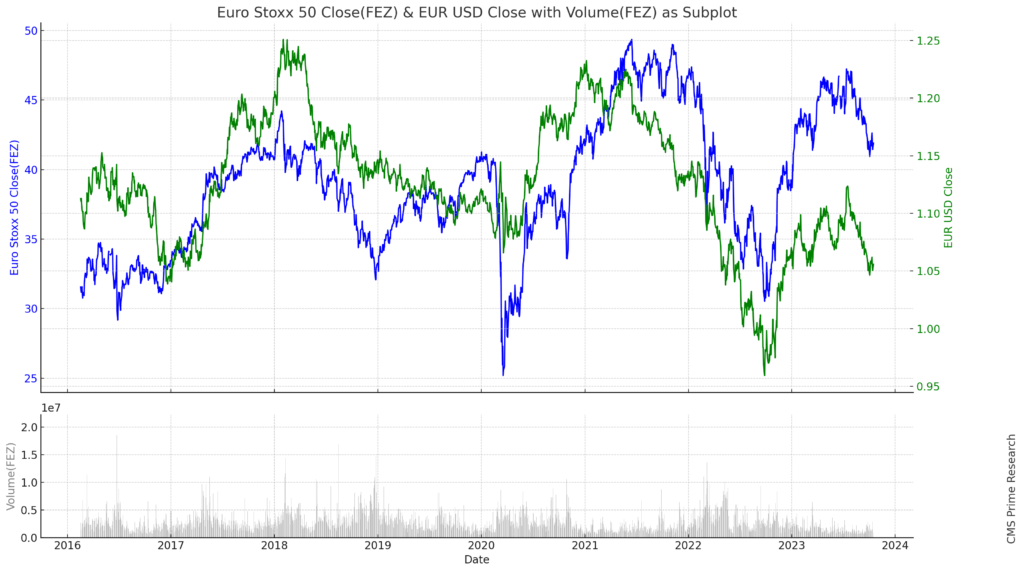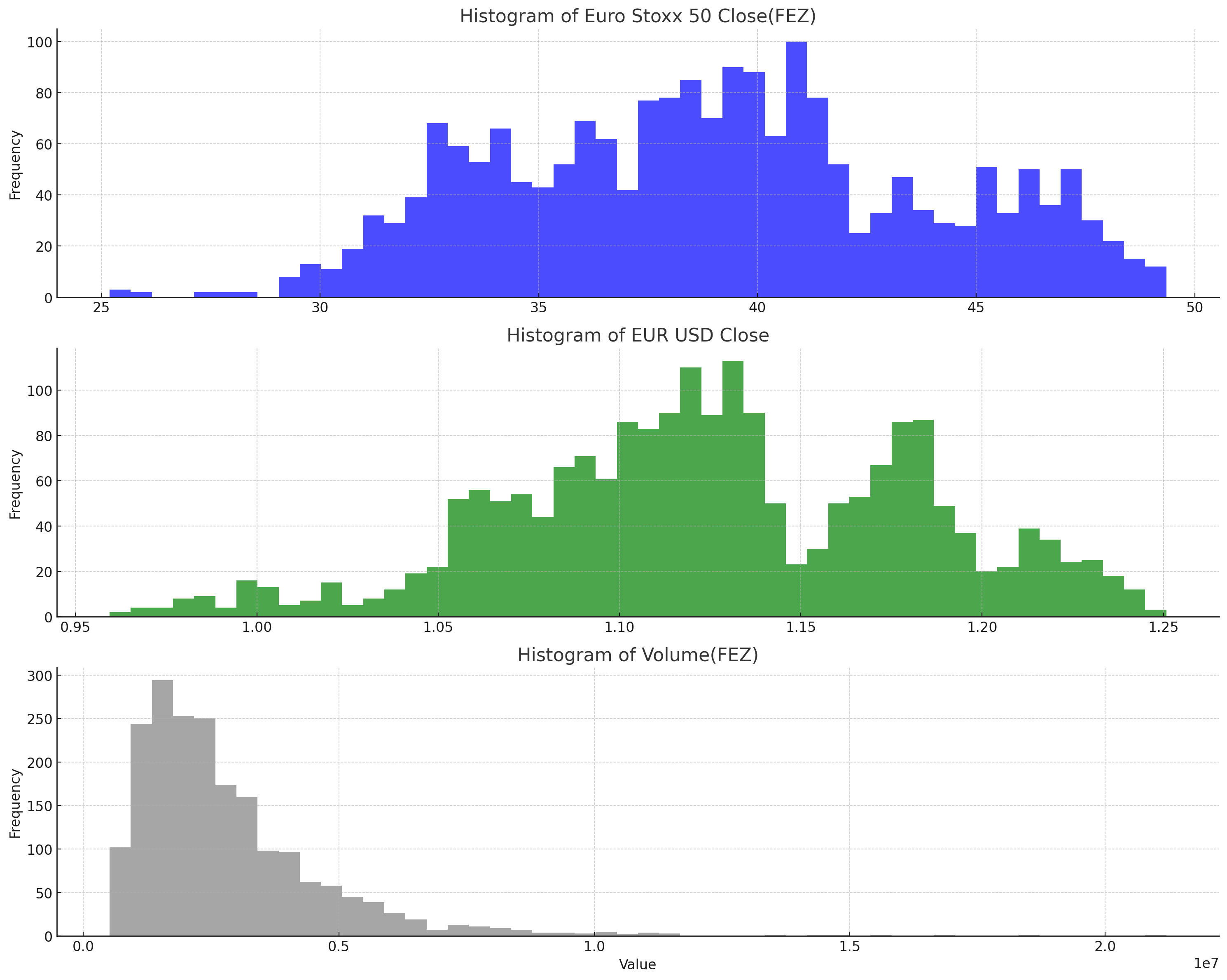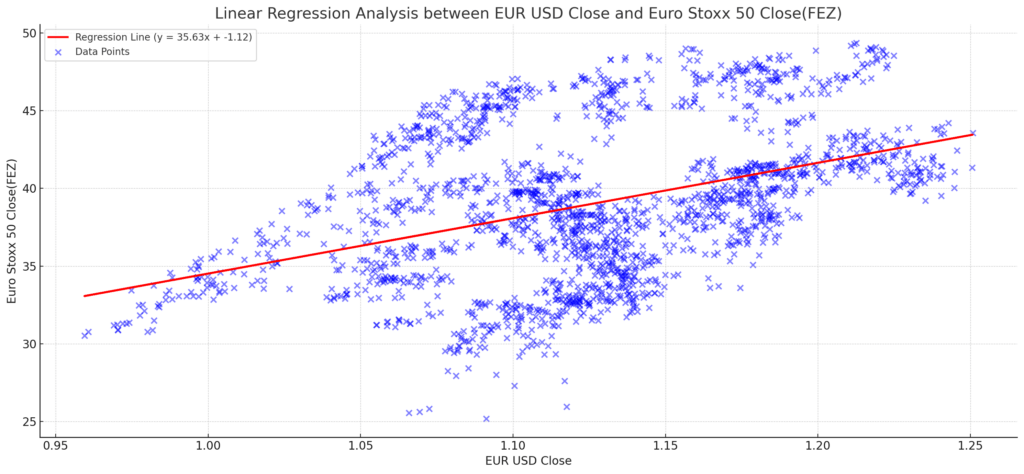
Introduction:
The financial markets are vast arenas where numerous factors interplay to determine the movement of indices and exchange rates. The Euro Stoxx 50, representing 50 major companies in the Eurozone, and the EUR-USD exchange rate, which denotes the value of one Euro in terms of US dollars, are two critical indicators that investors and analysts keenly observe. By examining their historical data, patterns, and relationships, one can glean insights into the broader market dynamics. In this analysis, we delve into the intricacies of the Euro Stoxx 50 index and the EUR-USD exchange rate, exploring their distributions, examining their relationship through statistical tests, and shedding light on the implications of the observed patterns. The aim is to provide a comprehensive understanding of these two financial indicators and how they might influence each other.
Data and Imputation:
The dataset contains the following columns:
- Date: The date of the data point.
- Euro Stoxx 50 Close(FEZ): The closing value of the Euro Stoxx 50 index for the given date.
- EUR USD Close: The closing value of the EUR to USD exchange rate for the given date.
- Volume(FEZ): The trading volume of the Euro Stoxx 50 index for the given date.

For data imputation we used the previous close values as a missing value parameter. Imputing the missing values using the previous day’s close is known as forward filling. This approach is particularly suitable for time series data, as it assumes continuity in the data points.
Analysis of the Distributions
- Euro Stoxx 50 Close(FEZ) (Blue Histogram):
- Appears to be somewhat normally distributed with a slight right skew.
- Most of the values seem to be centered around a specific range, which suggests that the Euro Stoxx 50 index usually trades within this range.
- EUR USD Close (Green Histogram):
- The distribution also appears to be somewhat normally distributed.
- The bulk of the values seem to be centered around a particular range, indicating that the EUR-USD exchange rate mostly fluctuates within this range.

- Volume(FEZ) (Gray Histogram):
- This histogram has a pronounced right skew, indicating that there are many days with lower trading volumes and fewer days with exceptionally high trading volumes.
- Most of the trading days have volumes in the lower range, with a few days experiencing a surge in trading volume.
Analysis:
- Similarities: Both the Euro Stoxx 50 Close(FEZ) and EUR USD Close histograms show a somewhat bell-shaped distribution, suggesting that these values mostly revolve around a central range with occasional deviations.
- Differences: The Volume(FEZ) histogram stands out from the other two due to its pronounced skewness. This suggests that trading volumes can be quite unpredictable, with sporadic spikes.
- Oddities: There aren’t glaring oddities in the histograms. However, the right skew in the trading volume could warrant a deeper investigation to understand the factors behind the occasional surges in volume.
Testing for Statistical Relationship:
Correlation Study:
The Pearson correlation coefficient between the EUR USD Close and Euro Stoxx 50 Close(FEZ) was computed to be approximately 0.4140.414
This value suggests a moderate positive linear relationship between the two variables. An increase in the EUR-USD exchange rate is associated with an increase in the Euro Stoxx 50 index, albeit not perfectly linearly.
While correlation indicates the strength and direction of a linear relationship, it does not imply causation.
Linear Regression Analysis:
Model: Euro Stoxx 50 Close(FEZ)=35.63×EUR USD Close−1.12
Results:
Slope: Approximately 35.63
For every unit increase in the EUR USD Close, the Euro Stoxx 50 Close(FEZ) is expected to increase by approximately 35.63 units, ceteris paribus.
Intercept: Approximately −1.12
Theoretically, this suggests that if the EUR USD Close were zero, the Euro Stoxx 50 Close(FEZ) would be −1.12. However, this interpretation is not practically relevant, given the nature of the variables.
Coefficient of Determination (R2): 0.171
Approximately 17.1% of the variance in the Euro Stoxx 50 Close(FEZ) can be accounted for by the EUR USD Close. This implies that there are other factors, external to this model, affecting the Euro Stoxx 50 index’s movement

Here’s the scatter plot visualizing the relationship between EUR USD Close and Euro Stoxx 50 Close(FEZ):
- Data Points (in blue): Represent individual observations of the EUR USD Close against the corresponding Euro Stoxx 50 Close(FEZ).
- Regression Line (in red): Represents the linear relationship derived from the regression analysis. The equation for this line is y=35.63x−1.12, where y is the Euro Stoxx 50 Close(FEZ) and x is the EUR USD Close.
From the plot, we can observe the positive slope of the regression line, indicating that as the EUR USD Close increases, the Euro Stoxx 50 Close(FEZ) tends to increase as well. However, the spread of the blue data points around the red line also illustrates the variability that is not captured by the regression model, underscoring the R2 value of 0.171 that we discussed earlier.
While there is a discernible positive relationship between the EUR-USD exchange rate and the Euro Stoxx 50 index, it is essential to approach investment decisions holistically. The EUR-USD exchange rate can provide insights into market movements, but relying solely on this relationship without considering other influential variables could be risky.
Conclusion:
Our exploration into the Euro Stoxx 50 and EUR-USD exchange rate has provided us with intriguing insights into their behavior and relationship. The distributions of the two entities hint at certain stability, with the majority of values centered around specific ranges. The correlation study reinforced the notion of a moderate positive relationship between them, suggesting that they move in tandem to some extent. However, our regression analysis highlighted that the EUR-USD exchange rate only explains about 17.1% of the variance in the Euro Stoxx 50 index, indicating the presence of other influential factors. The scatter plot further visualized this relationship, emphasizing the importance of understanding variability and not relying solely on a single factor. In the dynamic world of finance, it’s paramount to adopt a multifaceted approach. While the relationship between the Euro Stoxx 50 and EUR-USD offers valuable insights, it’s crucial to consider the broader picture, integrating other influential variables, and trends to make informed and holistic investment decisions.
Disclaimer: This is not an Investment Advice. Investing and trading in currencies involve inherent risks. It’s essential to conduct thorough research and consider your risk tolerance before engaging in any financial activities.


